The Best Way To Get Yourself Unstuck - A Buyer's Guide To Recovery Track
Here is a buyer’s guide and real life test of seven recovery tracks popular on the market. Each track was tested on sand, mud and rock. This article was originally published in SA4x4's March 2014 issue with Grant Spolander as the journalist.These days, there’s a surprising number of truck track products available. Many sport unique designs and specialist features. But the fundamental purpose of any good recovery track remains the same. The purpose is to provide traction when there is no traction. That said, within the purpose there are various attributes that can be graded such as bridging, ease of use, durability and versatility.
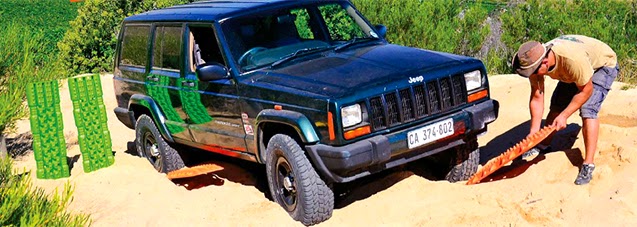
These days, there’s a surprising number of truck track products available. Many sport unique designs and specialist features. But the fundamental purpose of any good recovery track remains the same. The purpose is to provide traction when there is no traction. That said, within the purpose there are various attributes that can be graded such as bridging, ease of use, durability and versatility.
Getting Unstuck Is A Necessary Part Of Off-Roading
A few years ago, while driving through a jungle in Central Africa, we hit a 300-metre traffic jam of trucks, buses and cars backed up behind a stretch of mud. The local drivers weren’t fazed. The lead vehicle would disembark, unpack a pile of rocks and rebuild the road. Once through the boggy section, they collected their rocks, packed them back into the vehicle and went on their way. There was no concern for the next vehicle in line. That driver would have his or her own rocks.
No one knows for sure when the first wheel was invented, but it is a good bet that truck track was invented shortly thereafter. Even if truck track back then was just a pile of gravel.
What Is Meant By Bridging When It Comes To Recovery Track?
Regarding bridging: This is the practice of using the tracks to bridge a gap in the terrain. It requires that the driver use two truck tracks stacked on top of each other because the weight of the vehicle would not be supported by just one.
Perforated Aluminium Planking (PAP)
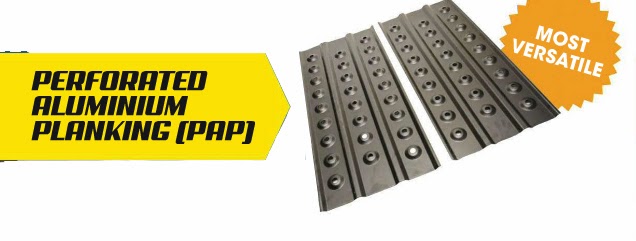
Arguably the oldest recovery track in the test, it is best known for its starring role in the Camel Trophy events in the glory days. Back then, this track was better known as Perforated Steel Planking. But today aluminum is the preferred metal because it resist rust and weighs less than steel.
The PAP system did very well during our test. This is especially true when tracks were stacked together as a bridging tool, showing minimal flexing or bowing. The PAPs are pretty wide as far as recovery tracks go and because of that they worked well in sand, offering very good flotation, broad weight distribution and added friction against the sand. However, their smooth surface finish works against them in wet or muddy conditions, particularly on an incline when the vehicle’s mass works against it.
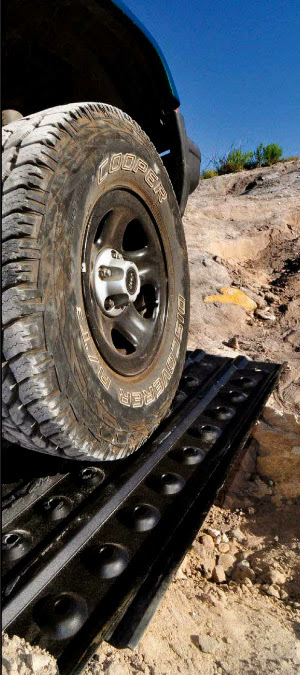
The greatest feature of the PAP tracks is their versatility. You can use these tracks as a shower mat, roofrack deck, or (when placed between two ammo boxes) as a bench seat, day bed or low lying table. The other recovery tracks simply could not offer this level of versatility.
They weigh 19 pound 13 ounces. That makes them on the heavy side for recovery tracks. They are coated in a black powder that heats up in the sun. Given their overall performance and versatility, they are impressive tried-and-true recovery tracks.
| WRAP UP | |
| LIKES | DISLIKES |
| Excellent versatility | Somewhat heavy and tricky to carry |
| Easy to use | Slippery when wet |
| Great performance in sand | Low elasticity – once they are bent you can not get them straight again. |
| Good bridging tool- however they can slip out from under one another | |
| Very durable with a long life | |
Rampage GripTrack
The GripTrack by Rampage are unique in that they boast a hinged design that allows them to be neatly packed away in the trunk of your truck. These tracks are easy to handle and maneuver into place.
The Rampage GripTrack are manufactured with high-density plastic and their traction grooves/ridges are fairly well sized. So they last a very, very long time.
These do not offer the best floatation, because they are broken up into sections. Plus you need to accelerate slowly with these tracks when you are on sand. If you accelerate too quickly they will dig into the sand and disappear.
For the most part, the Rampage GripTrack did successfully retrieve the vehicles tested. But it is not wise to use these tracks as a bridging tool because they are sectional. So their use is limited to sand and mud. For the price these are hard to beat in the sand and mud department.
| WRAP UP | |
| LIKES | DISLIKES |
| Highly space-efficient | Poor flotation |
| Durable build quality | No bridging capabilities |
| Effective traction in sand and mud | |
| Competitive price | |
ARB 4X4 Bushranger Sand Tracks
At 36 pounds per pair the ARB 4X4 Bushranger Sand Tracks are cumbersome and difficult to carry. In addition, their extreme flexibility is a fault rather than an attribute when it comes to how difficult it is to position the track under the tires of your rig. If you drag one end out of line, the other end stays where it is, so you have to move along the track’s length and push/pull the entire length into a straight line.
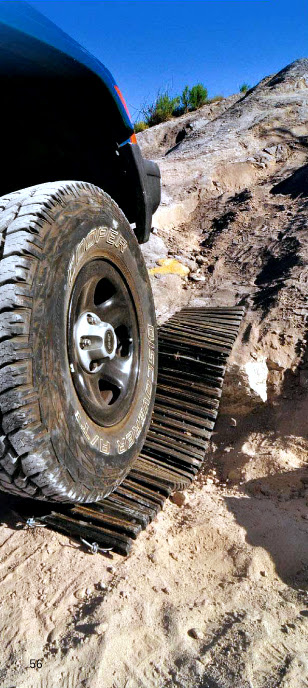
They are not so easy to pack when you are finished. You need two guys to pack these away. If one guy tries to do it by himself he will end up with black rubber marks on his stomach, on his thighs and on his knees.
These tracks are bulky, heavy and take time to put into place. They can not be used as bridging tools and in sand they tend to dig in due to their poor floatation. They did successfully recover the vehicle, but just barely.
What these tracks are good for is to prevent drivers from having to do recovery in the first place. These tracks are good to lay down in front of the vehicle’s wheels when the driver sees an upcoming traction problem. The driver can get out and lay these tracks down in advance to get out of any tricky parts of the trail. Because these tracks are fairly long, they are ideal for laying across mud ruts in advance. So these are much more “ounce of prevention” than “pound of cure” tracks.
| WRAP UP | |
| LIKES | DISLIKES |
| Affordability | Bulkiness |
| Generous length | Heaviness |
| Extreme flexibility | |
Lizard Recovery Tracks


The Lizard tracks are made from 5 millimeter fiberglass board and coated with a sandy grit. The trouble is that the underside of the track is totally smooth, much like a sand-board. The friction difference between the top of the track and the bottom of the track is extreme.
As a result, these tracks totally failed during recovery testing. They failed during straight recovery testing and they failed during floatation testing and bridge testing. They are too slippery and too flexible.
| WRAP UP | |
| LIKES | DISLIKES |
| Light weight | Too flexible |
| Space efficiency | No flotation |
| Not enough underbody traction | |
MaxTrax, the Australian Original
Since their local launch in 2008, these Australian made recovery tracks have proved their worth over and over to off-roaders worldwide. They are strong, ergonomic and multi-functional, but above all, Maxtrax provide excellent traction across most terrain types.
Much of their traction performance is due to the many lugs that protrude from the top and bottom of the track, creating friction between your rig tire and the surface beneath the Maxtrax. They also feature a pocket design on the underside of the track; this system gathers sand and creates added resistance to slippage.
The reinforced nylon tracks are so tough and hardy that they work incredibly well as a bridging tool when coupled together. And because they fit so neatly together, there’s no chance that the tracks will slip apart. This also makes Maxtrax super-easy to store and very space-efficient.

In 2012 Maxtrax launched a revised model with further functionality. The tracks were made shorter and thinner, which also lowered their weight. The edges were smoothed out so the tracks were more comfortable to carry.
With the six grab handles you can invert your Maxtrax and use it as a shovel. Or you can place the track upside down beneath your rig and drag it back and forth in a sawing motion, the little cups will gather sand and push it away.
The tracks include peg holes for additional anchoring, and you can link the tracks lengthways with an aftermarket Maxtrax accessory. Finally, because they are bright and orange, they are always easy to find in dark mud.
Because of all the versatility and useful attributes, Maxtrax gets the title of Best Overall Performer. Maxtrax offer superior traction, excellent functionality, outstanding durability and the most ergonomic design by far.
| WRAP UP | |
| LIKES | DISLIKES |
| Excellent traction on all surfaces | Price |
| Incredibly tough | |
| Great bridging tool with elastic properties | |
| Multi-functional shovel feature | |
| Terrific ergonomics and ease of use | |
TREDs
Launched earlier last year, TJM’s TRED Tracks bear a close resemblance to the MaxTrax design. They’re similarly shaped and proportioned, and as stiff and hardy. As a result, the TRED’s perform just as well as MaxTrax in sand, in mud and as a bridging tool.
There is one area in which TREDs do not perform as well and that is comfort. The TREDs have wrap-around handles that aren’t as comfortable as the MaxTrax’s hollow-insert handles. When stacked together, the TRED’s chunkier handles are roughly 3.34 inches thick, compared to just under 1 inch for the MaxTrax. So if you do not have monster size hands you are more likely to have a hard time holding on to the TREDs.
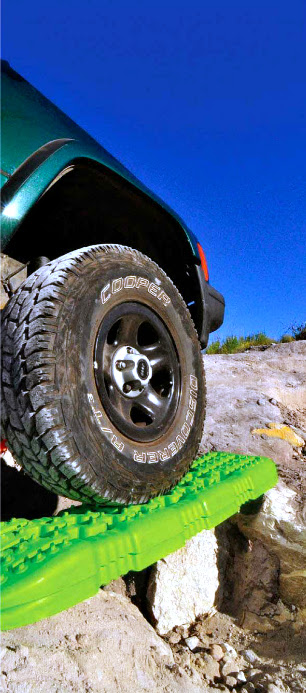
The other thing is that TREDs are single-directional; they have one ramping side that can be jammed under the tire of a vehicle. Over time this means the traction lugs will be worn flat. TREDs are going to wear flat twice as fast as the MaxTrax because TREDs only have one starting side.
These differences aside, the TREDs peformed as well as MaxTrax. But they do take up more space and they are not as ergonomically comfortable. If you have a tricked out rig you’ll be glad to learn that the TREDs come in color varieties.
| WRAP UP | |
| LIKES | DISLIKES |
| Excellent traction on all surfaces | Price |
| Incredibly tough | Ergonomically uncomfortable |
| Great bridging tool with elastic properties | |
| Multi-functional shovel feature | |
| Very durable with a long life | |
Desert Escaper Tracks

The Escaper Tracks are another imitation of the Maxtrax design, but they resemble the first-generation Maxtrax – not the latest model.
The Escaper Tracks work almost as well as the TREDS or MaxTrax, but their material choice is noticeably softer and more pliant. As a result, the Escaper Tracks show significant flex when used as a bridging tool. And they’re far more likely to wear. In fact, they probably will not last long.
Another minus is that they do not pack well together. They sit one atop the other in a loose way that is not easy to carry or easy to store. Because they do not snap together on top of one another they are not able to be used as a bridging tool.
But, you get what you pay for and the Escaper Tracks are considerably more affordable than MaxTrax or TREDs.
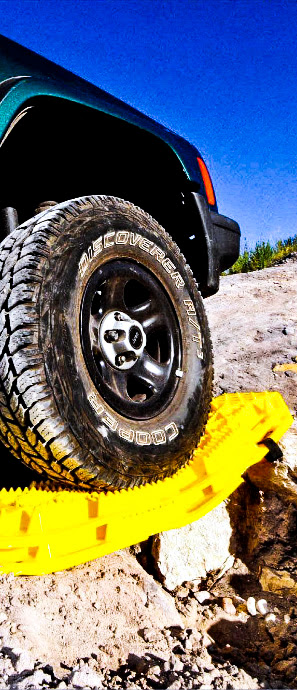
| WRAP UP | |
| LIKES | DISLIKES |
| Excellent traction on all surfaces | The plastic is kinda soft |
| Affordability | Product lifespan is not that long |
Conclusion
Testing a brand new 4x4 is tricky. The vehicle’s abilities have to be matched with a suitable test venue. The preference was for trails that would push vehicle capabilities without causing damage. But, as many readers are aware, once on a trail one can sometimes pass the point of no return.
Testing 4x4s typically is done with no backup vehicle. Testing that goes on during the week frequently means no assistance from the trail owner is available. Getting stuck happens, a lot. But it is through those experiences that getting unstuck techniques and strategies are perfected.
Many years ago, before they were sold in South Africa, the Australian manufacturers of MaxTrax sent over a review pair. It was the review that lead to MaxTrax being sold in South Africa and since that time it has been habit to bring a trusty pair of MaxTrax with us when testing 4x4s. In all those years of abuse the MaxTrax pair has only just now developed a small crack.
As said earlier, you get what you pay for and MaxTrax are the least affordable recovery tracks on the market. A lot of off-roaders are going to be price sensitive and choose a different brand, and that is understandable. But for the number of years MaxTrax have lasted us we’d say the price is worth it.
For functionality, the PAP tracks are also a draw. It is so cool that they have so many other uses. Because they are so versatile, it could be that PAP tracks are best suited for overlanders while Maxtrax are meant for extreme 4x4-ers and trail lovers.
The biggest thing we noticed during testing was the importance of rigidity. It improves the use of the tracks as a bridging tool or ramp and it also aids floatation. In addition a rigid track can be used as a step tool that raises your rig ground clearance away from sand as the tire climbs on board. Lifting the tire out of the sand automatically reduces drag.
Do not forget recovery tracks as a preventative tool. If you are driving a tricky trail keep recovery tracks nearby and don’t think twice about using them to aid your vehicle over a section you think might get you stuck. Being proactive will prevent damage to your rig. And used as a preventative tool any rigid recovery track will do, even the cheapest model, or some branches or a rock or two in a pinch.

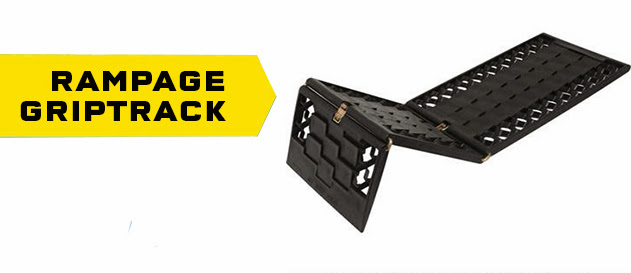
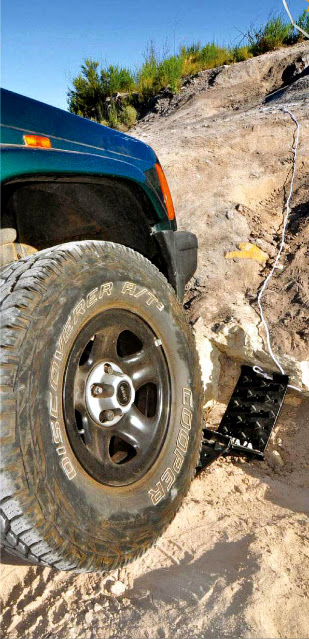



Post a Comment